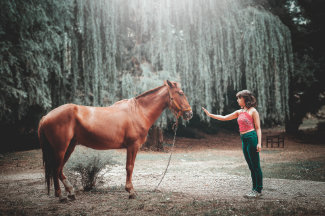Equine Assisted Therapy
Many years of studying the relationship between humans and horses have led therapists to realize the potential for healing through the use of horses. Equine Therapy and Equine Assisted Learning use the horse as a tool for psychotherapy in an experiential approach to teaching emotional well-being and growth. Sessions with an experienced psychotherapist and a horse as co-therapist have become recognized as opportunities for resounding insights and profound movement that sometimes has not occurred for clients in more traditional forms of talk therapy.
Horses seem to help us come to the core of mental health work: the awareness and safe expression of emotions. For most of us, feelings come up in the presence of horses, whether we’ve had connection with horses or not, whether those experiences have been satisfying or frustrating, whether the feelings are of fear or comfort. With the horse as a mirror and the human therapist as a guide, clients are often able to release emotions that have become a maze of depression, anxiety addictions, or messy relationships. The process challenges clients to learn about themselves and to process emotional issues, to develop better relationships and to increase their confidence – all in a non-threatening way. At the same time the horse offers an honest, visible relationship. If a horse if bored, it will walk away; if he’s afraid, he’ll tremble, if she’s intrigued, she’ll come closer. He or she responds to human emotion with acute sensitivity and acts in accordance: a feedback monitor with unerring accuracy and a heart of gold.
Success in this therapeutic process is not dependent on a person’s experience with horses. Instead, change occurs as a result of the client’s ability to be open and willing.
Therapeutic services offered
- Individuals, Couples, Families & Groups
- Team and Community building
- Wilderness experiences
For more information contact:
Steven Hines 847-577-4530 ext.16
Steven is a Licensed Clinical Social Worker. Steven has been at the Arlington Center for over 20 years and before that was the director of the college counseling center at Trinity University in Deerfield, IL. He has over 27 years of experience doing therapy with adults, couples, adolescents, and groups. In addition, he has over 37 years of experience working and learning with horses. For the past 14 years he has been able to combine these passions in doing equine assisted therapy for individuals, families, couples, and groups.
Steven also leads week-long group retreats with OnSite in the Bob Marshall Wilderness of Montana each year. Visit their website for more information.
More on Team Building
Leadership staffs and teams, regardless of the organization, form a community. In order to be effective, productive, and achieve common goals, communities must work on their ability to relate and communicate together. Equine-assisted team and community-building provides an opportunity that is unique and different from any other team building experience. In this approach the horse is a living, breathing, reacting part of the experience. The horse gives honest, immediate, consistent feedback. As the group works through different team building exercises with the horse, the horse both mirrors and responds to the dynamics that are happening within the group.
Groups between 4 and 10 participants are given tasks to try and accomplish with the horse. Most of what happens with each task is a metaphor for the way the group relates and works together in the “real world”. No horse experience is necessary. Groups can choose between a half-day or a full day depending on their objectives and goals. The half-day experience allows the time for the group to go through at least one task with one or more horses and to get a picture of how the group functions. The group works together with each person working on their role and part of the group. The full day gives more opportunity to go to a deeper level and to work through more issues or possible conflicts within the group.
Possible Topics and Objectives
- Problem-solving as a community
- Verbal and non-verbal communication
- Learn about what role you play in the group
- See how your style or approach works or doesn’t work within the community
- Develop openness and honesty within your community
- Clear up communication with members, work through blocks that are holding your group back from truly functioning as a team
- Experience success functioning with “clean” communication using all group members
It is recommended that the team leader have a consultation with the facilitator prior to the team building to determine appropriate topics and objectives for your group.


